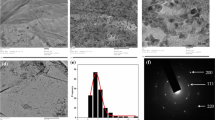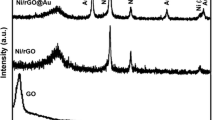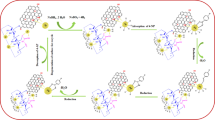Abstract
The design of ultrafine, highly efficient and recyclable heterogeneous bimetallic nanoparticles catalysts is challenging. In this work, we report for the first time the preparation of ultrafine and monodispersed bimetallic RhAg nanoparticles that are uniformly supported on reduced graphene oxide (rGO) nanosheets (RhAg/rGO). A key is the presence of the tris(triazolyl)-polyethylene glycol (tristrz-PEG) ligand as a weak stabilizing agent. This amphiphilic tridentate ligand not only enables the formation of ultrafine RhAg NPs, but also allows quantitative fixation of the NPs onto the rGO, which avoids metal loss and further improves catalytic efficiency. The RhAg/rGO catalysts were characterized by various techniques including UV–Vis, ICP-AES, TEM, HRTEM, STEM, EDX and XPS. By varying the molar ratios of Rh to Ag, the highest catalytic activity in the reduction of 4-nitrophenol by NaBH4 was obtained for RhAg0.5/rGO with a remarkable reaction rate of k app = 14.8 × 10−3 s−1 (k nor = 1415 s−1 g−1). Moreover, the catalyst was recycled, and its amount was reduced to 100 ppm of RhAg0.5/rGO while retaining an exceptional catalytic efficiency. The present work contributes to the effective design of ultrafine bimetallic NPs/graphene-based nanocomposites and to the fabrication of very efficient and cost-effective catalysts.





Similar content being viewed by others
References
Toshima N, Yonezawa T (1998) Bimetallic nanoparticles—novel materials for chemical and physical applications. New J Chem 122:1179–1201
Sankar M, Dimitratos N, Miedziak PJ, Wells PP, Kiely CJ, Hutchings GJ (2012) Designing bimetallic catalysts for a green and sustainable future. Chem Soc Rev 41:8099–8139
Wang D, Li Y (2011) Bimetallic nanocrystals: liquid-phase synthesis and catalytic applications. Adv Mater 23:1044–1060
Liu X, Wang D, Li Y (2012) Synthesis and catalytic properties of bimetallic nanomaterials with various architectures. Nano Today 7:448–466
Peng X, Pan Q, Rempel GL (2008) Bimetallic dendrimer-encapsulated nanoparticles as catalysts: a review of the research advances. Chem Soc Rev 37:1619–1628
Wu B, Zheng N (2013) Surface and interface control of noble metal nanocrystals for catalytic and electrocatalytic applications. Nano Today 8:168–197
Gawande MB, Goswami A, Asefa T, Guo H, Biradar AV, Peng D, Zboril R, Varma RS (2015) Core–shell nanoparticles: synthesis and applications in catalysis and electrocatalysis. Chem Soc Rev 44:7540–7590
Crooks RM, Zhao MQ, Sun L, Chechik V, Yeung LK (2001) Dendrimer-encapsulated metal nanoparticles: synthesis, characterization, and applications to catalysis. Acc Chem Res 34:181–190
Myers VS, Weir MG, Carino EV, Yancey DF, Pande S, Crooks RM (2011) Dendrimer-encapsulated nanoparticles: new synthetic and characterization methods and catalytic applications. Chem Sci 2:1632–1646
Gao F, Goodman DW (2012) Pd–Au bimetallic catalysts: understanding alloy effects from planar models and (supported) nanoparticles. Chem Soc Rev 41:8009–8020
Ferrando R, Jellinek J, Johnston RL (2008) Nanoalloys: from theory to applications of alloy clusters and nanoparticles. Chem Rev 106:845–910
Hutchings GJ, Kiely CJ (2013) Strategies for the synthesis of supported gold palladium nanoparticles with controlled morphology and composition. Acc Chem Res 46:1759–1772
Edwards JK, Freakley SJ, Carley AF, Kiely CJ, Hutchings GJ (2014) Strategies for designing supported gold–palladium bimetallic catalysts for the direct synthesis of hydrogen peroxide. Acc Chem Res 47:845–854
Zhang L, Xie Z, Gong J (2016) Shape-controlled synthesis of Au–Pd bimetallic nanocrystals for catalytic applications. Chem Soc Rev 45:3916–3934
Astruc D, Lu F, Ruiz J (2005) Nanoparticles as recyclable catalysts: the frontier between homogeneous and heterogeneous catalysis. Angew Chem Int Ed 44:7852–7872
Zhang HJ, Watanabe T, Okumura M, Haruta M, Toshima N (2012) Catalytically highly active top gold atom on palladium nanocluster. Nat Mater 11:49–52
Aita T, Kohyama M, Haruta M (2013) Electron microscopy study of gold nanoparticles deposited on transition metal oxides. Acc Chem Res 46:1773–1782
Lopez-Sanchez JA, Dimitratos N, Hammond C, Brett GL, Kesavan L, White S, Miedziak P, Tiruvalam R, Jenkins RL, Carley AF, Knight D, Kiely CJ, Hutchings GJ (2011) Facile removal of stabilizer-ligands from supported gold nanoparticles. Nat Chem 3:551–556
Sarina S, Zhu H, Jaatinen E, Xiao Q, Liu H, Jia J, Chen C, Zhao J (2013) Enhancing catalytic performance of palladium in gold and palladium alloy nanoparticles for organic synthesis reactions through visible light irradiation at ambient temperatures. J Am Chem Soc 135:5793–5801
Jiang HL, Xu Q (2011) J Mater Chem 21:13705–13725
Singh AK, Singh AK, Xu Q (2013) Synergistic catalysis over bimetallic alloy nanoparticles. ChemCatChem 5:652–676
Yuan Y, Yan N, Dyson PJ (2012) Advances in the rational design of rhodium nanoparticle catalysts: control via manipulation of the nanoparticle core and stabilizer. ACS Catal 2:1057–1069
Garcia S, Zhang L, Piburn GW, Henkelman G, Humphrey SM (2014) Microwave synthesis of classically immiscible rhodium–silver and rhodium–gold alloy nanoparticles: highly active hydrogenation catalysts. ACS Nano 8:11512–11521
Yasukawa T, Miyamura H, Kobayashi S (2012) Polymer-incarcerated chiral Rh/Ag nanoparticles for asymmetric 1,4-addition reactions of arylboronic acids to enones: remarkable effects of bimetallic structure on activity and metal leaching. J Am Chem Soc 134:16963–16966
Yasukawa T, Suzuki A, Miyamura H, Nishino K, Kobayashi S (2015) Chiral metal nanoparticle systems as heterogeneous catalysts beyond homogeneous metal complex catalysts for asymmetric addition of arylboronic acids to α, β-unsaturated carbonyl compounds. J Am Chem Soc 137:6616–6623
Hirakawa K, Toshima N (2003) Ag/Rh bimetallic nanoparticles formed by self-assembly from Ag and Rh monometallic nanoparticles in solution. Chem Lett 32:8–79
Toshima N, Kanemaru M, Shiraishi Y, Koga Y (2005) Spontaneous formation of core/shell bimetallic nanoparticles: a calorimetric study. J Phys Chem B 109:16326–16331
Yang A, Sakata O, Kusada K, Yayama T, Yoshikawa H, Ishimoto T, Koyama M, Kobayashi H, Kitagawa H (2014) The valence band structure of AgxRh1–x alloy nanoparticles. Appl Phys Lett 105:153109
Kusada K, Yamauchi M, Kobayashi H, Kitagawa H, Kubota Y (2010) Hydrogen-storage properties of solid-solution alloys of immiscible neighboring elements with Pd. J Am Chem Soc 132:15896–15898
Dai Y, Wang Y, Liu B, Yang Y (2015) Metallic nanocatalysis: an accelerating seamless integration with nanotechnology. Small 11:268–289
Chen S, Thota S, Wang X, Zhao J (2016) From solid to core@shell to hollow Pt–Ag nanocrystals: thermally controlled surface segregation to enhance catalytic activity and durability. J Mater Chem A 4:9038–9043
Roy A, Debnath B, Sahoo R, Chandrakumar KRS, Ray C, Jana J, Pal T (2016) Enhanced catalytic activity of Ag/Rh bimetallic nanomaterial: evidence of an ensemble effect. J Phys Chem C 120:5457–5467
Wang C, Ciganda R, Salmon L, Gregurec D, Irigoyen J, Moya S, Ruiz J, Astruc D (2016) Highly efficient transition metal nanoparticle catalysts in aqueous solutions. Angew Chem Int Ed 55:3091–3095
Wang C, Wang D, Yu S, Cornilleau T, Ruiz J, Salmon L, Astruc D (2016) Design and applications of an efficient amphiphilic “click” CuI catalyst in water. ACS Catal 6:5424–5431
Özçubukçu S, Ozkal E, Jimeno C, Pericas MA (2009) A highly active catalyst for huisgen 1, 3-dipolar cycloadditions based on the tris(triazolyl) methanol-Cu(I) structure. Org Lett 11:4680–4683
Radich JG, Kamat PV (2013) Making graphene holey. gold-nanoparticle-mediated hydroxyl radical attack on reduced graphene oxide. ACS Nano 7:5546–5557
Deraedt C, Wang D, Salmon L, Etienne L, Labrugère C, Ruiz J, Astruc D (2015) Robust, efficient, and recyclable catalysts from the impregnation of preformed dendrimers containing palladium nanoparticles on a magnetic support. ChemCatChem 7:303–308
Kim SM, Qadir K, Seo B, Jeong HY, Joo SH, Terasaki O, Park JY (2013) Nature of Rh oxide on Rh nanoparticles and its effect on the catalytic activity of CO oxidation. Catal Lett 143:1153–1161
Kim S, Qadir K, Jin S, Reddy AS, Seo B, Mun BS, Joo SH, Park JY (2012) Trend of catalytic activity of CO oxidation on Rh and Ru nanoparticles: role of surface oxide. Catal Today 185:131–137
Prinz J, Gaspari R, Stöckl QS, Gille P, Armbrüster M, Brune H, Gröning O, Pignedoli CA, Passerone D, Widmer R (2014) Ensemble effect evidenced by CO adsorption on the 3-fold PdGa surfaces. J Phys Chem C 118:12260–12265
Sau TK, Pal A, Pal T (2001) Size regime dependent catalysis by gold nanoparticles for the reduction of eosin. J Phys Chem B 105:9266–9272
Pal AA, Pal T (2015) Nitroarene reduction: a trusted model reaction to test nanoparticle catalysts. Chem Commun 51:9410–9431
Hervés P, Pérez-Lorenzo M, Liz-Marzán LM, Dzubiella J, Lu Y, Ballauff M (2012) Catalysis by metallic nanoparticles in aqueous solution: model reactions. Chem Soc Rev 41:5577–5587
Zhao P, Feng X, Huang D, Yang G, Astruc D (2015) Basic concepts and recent advances in nitrophenol reduction by gold-and other transition metal nanoparticles. Coord Chem Rev 287:114–136
Kuroda K, Ishida T, Haruta M (2009) Reduction of 4-nitrophenol to 4-aminophenol over Au nanoparticles deposited on PMMA. J Mol Catal A: Chem 298:7–11
Wunder S, Polzer F, Lu Y, Ballauff M (2010) Kinetic analysis of catalytic reduction of 4-nitrophenol by metallic nanoparticles immobilized in spherical polyelectrolyte brushes. J Phys Chem C 114:8814–8820
Saha S, Pal A, Kundu S, Basu S, Pal T (2010) Photochemical green synthesis of calcium-alginate-stabilized Ag and Au nanoparticles and their catalytic application to 4-nitrophenol reduction. Langmuir 26:2885–2893
Wang SN, Zhang MC, Zhang WQ (2011) Yolk − shell catalyst of single Au nanoparticle encapsulated within hollow mesoporous silica microspheres. ACS Catal 1:207–211
Wunder S, Lu Y, Albrecht M, Ballauff M (2011) Catalytic activity of faceted gold nanoparticles studied by a model reaction: evidence for substrate-induced surface restructuring. ACS Catal 1:908–916
Li J, Liu CY, Liu Y (2012) Au/graphene hydrogel: synthesis, characterization and its use for catalytic reduction of 4-nitrophenol. J Mater Chem 22:8426–8430
Zhang J, Han D, Zhang H, Chaker M, Zhao Y, Ma D (2012) In situ recyclable gold nanoparticles using CO2-switchable polymers for catalytic reduction of 4-nitrophenol. Chem Commun 48:11510–11512
Shivhare A, Ambrose SJ, Zhang H, Purves RW, Scott RWJ (2013) Stable and recyclable Au25 clusters for the reduction of 4-nitrophenol. Chem Commun 49:276–278
Pachfule P, Kandambeth S, Dıaz D, Banerjee R (2014) Highly stable covalent organic framework–Au nanoparticles hybrids for enhanced activity for nitrophenol reduction. Chem Commun 50:3169–3171
Gu S, Wunder S, Lu Y, Ballauff M (2014) Kinetic analysis of the catalytic reduction of 4-nitrophenol by metallic nanoparticles. J Phys Chem C 118:18618–18625
Wu T, Zhang L, Gao J, Liu Y, Gao C, Yan J (2013) Fabrication of graphene oxide decorated with Au–Ag alloy nanoparticles and its superior catalytic performance for the reduction of 4-nitrophenol. J Mater Chem A 1:7384–7390
Lv JJ, Wang AJ, Ma X, Xiang RY, Chen JR, Feng JJ (2015) One-pot synthesis of porous Pt–Au nanodendrites supported on reduced graphene oxide nanosheets toward catalytic reduction of 4-nitrophenol. J Mater Chem A 3:290–296
Song P, He LL, Wang AJ, Mei LP, Zhong SX, Chen JR, Feng JJ (2015) Surfactant-free synthesis of reduced graphene oxide supported porous PtAu alloyed nanoflowers with improved catalytic activity. J Mater Chem A 3:5321–5327
Gupta VK, Atar N, Yola ML, Ustundag Z, Uzun L (2014) A novel magnetic Fe@Au core–shell nanoparticles anchored graphene oxide recyclable nanocatalyst for the reduction of nitrophenol compounds. Water Res 48:210–217
Shen YY, Sun Y, Zhou LN, Li YJ, Yeung ES (2014) Synthesis of ultrathin PtPdBi nanowire and its enhanced catalytic activity towards p-nitrophenol reduction. J Mater Chem A 2:2977–2984
Liu Q, Xu Y, Wang A, Feng J (2015) One-step melamine-assisted synthesis of graphene-supported AuPt@Au nanocrystals for enhanced catalytic reduction of p-nitrophenol. RSC Adv 5:96028–96033
Mei LP, Wang R, Song P, Feng JJ, Wang ZG, Chen JR, Wang AJ (2016) One-pot solvothermal synthesis of bimetallic yolk–shell Ni@PtNi nanocrystals supported on reduced graphene oxide and their excellent catalytic properties for p-nitrophenol reduction. New J Chem 40:2315–2320
Lee Y, Jang S, Cho C-W, Bae J-S, Park S, Park KH (2013) Recyclable rhodium nanoparticles: green hydrothermal synthesis, characterization, and highly catalytic performance in reduction of nitroarenes. J Nanosci Nanotechnol 13:7477–7481
Lin C, Wu G, Li H, Geng Y, Xie G, Yang J, Liu B, Jin J (2017) Nanoscale 9:1834–1839
Liu CH, Chen XQ, Hu YF, Sham TK, Sun QJ, Chang JB, Gao X, Sun XH, Wang SD (2013) One-pot environmentally friendly approach toward highly catalytically active bimetal-nanoparticle-graphene hybrids. ACS Appl Mater Interfaces 5:5072–5079
Tang S, Vongehr S, He G, Chen L, Meng X (2012) Highly catalytic spherical carbon nanocomposites allowing tunable activity via controllable Au–Pd doping. J Colloid Interface Sci 375:125–133
Zhang L, Wu T, Xu X, Xia F, Na H, Liu Y, Qiu H, Wang W, Gao J (2015) Magnetic bimetallic nanoparticles supported reduced graphene oxide nanocomposite: fabrication, characterization and catalytic capability. J Alloy Compd 628:364–371
Wang Y, Wang X, Sun B, Tang S, Meng X (2016) Concentration-dependent morphology control of Pt-coated-Ag nanowires and effects of bimetallic interfaces on catalytic activity. J Mater Sci Technol 32:41–47
Lu W, Ning R, Qin X, Zhang Y, Chang G, Liu S, Luo Y, Sun X (2011) Synthesis of Au nanoparticles decorated graphene oxide nanosheets: noncovalent functionalization by TWEEN 20 in situ reduction of aqueous chloroaurate ions for hydrazine detection and catalytic reduction of 4-nitrophenol. J Hazard Mater 197:320–326
Ciganda R, Li N, Deraedt C, Gatard S, Zhao P, Salmon L, Hernandez R, Ruiz J, Astruc D (2014) Gold nanoparticles as electron reservoir redox catalysts for 4-nitrophenol reduction: a strong stereoelectronic ligand influence. Chem Commun 50:10126–10129
Deraedt C, Salmon L, Gatard S, Ciganda R, Hernandez R, Ruiz J, Astruc D (2014) Sodium borohydride stabilizes very active gold nanoparticle catalysts. Chem Commun 50:14194–14196
Wang D, Astruc D (2017) The recent development of efficient Earth-abundant transition metal nanocatalysts. Chem Soc Rev 46:816–854
Liu X, Astruc D (2017) From galvanic to anti-galvanic synthesis of bimetallic nanoparticles and applications to catalysis, sensing and materials science. Adv Mater. doi:10.1002/adma.201605305
Acknowledgements
Financial support from the China Scholarship Council (CSC) of the People’s Republic of China (Grant to C.W.), the Universities of Bordeaux, Toulouse 3, the LCC (Toulouse) and the Centre National de la Recherche Scientifique (CNRS) is gratefully acknowledged.
Author information
Authors and Affiliations
Corresponding author
Ethics declarations
Conflict of interest
The authors declare that they have no conflict of interest.
Electronic supplementary material
Below is the link to the electronic supplementary material.
Rights and permissions
About this article
Cite this article
Wang, C., Ciganda, R., Yate, L. et al. RhAg/rGO nanocatalyst: ligand-controlled synthesis and superior catalytic performances for the reduction of 4-nitrophenol. J Mater Sci 52, 9465–9476 (2017). https://doi.org/10.1007/s10853-017-1158-7
Received:
Accepted:
Published:
Issue Date:
DOI: https://doi.org/10.1007/s10853-017-1158-7




